Buyers have changed fundamentally. They are always connected and move across devices and channels seamlessly. In a world where customers receive more information and very little attention, organizations need to deliver relevant and contextual experiences. Focusing on customer insights in B2B provides tangible results.
Table of Contents
In today’s scenario, organizations realize the importance of customer insights, but capturing them can be challenging. The right customer insights can help the organizations deliver what the buyers are looking for and capture the market share from the competitor.
What are Customer Insights?
Customer insights are bits of knowledge and understanding gained through a study of the customer. Analyzing customer profiles and priorities with the help of customer sentiment analysis technique allows us to understand what drives the customer, what they want, and what they may need based on their preferences, challenges in the organization, or broader industry setting.
Customer insights can help organizations improve customer retention in SaaS as well as PaaS business.
You can make good use of your customer insights by leveraging advanced analytics techniques such as Churn Analytics and conveying these insights to the key stakeholders through data storytelling.
After doing consumer insight research correctly and highlighting the key takeaways through data stories, it should improve how you communicate with your customers, which in turn, will lead to a deeper relationship with them.
Customer Insights Vs Market Research
The difference lies in what and why. On one hand, the market research tells us about the customer profile, key statistics, and more. On the other hand, customer insights help us identify patterns about their priorities, the nuances that impact the customer, and much more.
Thus, it is about closing the loop on market research with context. In addition to this, the key difference is “INTELLIGENCE”. It’s all about connecting the dots from what you get to learn from research, tying with the context from intelligence, and closing the loop with the knowledge of buyer and seller stakeholders involved.
Customer Insights in a B2B Scenario
In B2B, there are only a few large customers. Also, the group of customers is heterogeneous according to their industry, size, and positioning.
In B2B, service provides look at customers, holistically, as an industry, an organization, a business line, a buying group, and specific stakeholders.
So, it becomes a time-consuming and challenging task to generate customer insights in B2B scenario.
Customer Insights in B2B Growth Process
The most crucial step is to generate 360-degree customer insights that create an overview of the customer’s entire profile and grow deeper relations and design strategies to penetrate further. Following is the model that lays down the path of how we can use customer insights in business.

Customer insights fuel the B2B growth process by providing ongoing and comprehensive intelligence to:
- Understand the customer business objectives and problems
- Identify whitespaces and stakeholders with a propensity to engage
- Leverage industry and customer business perspectives to solution effective outcomes
- Track key stakeholder movements and pain points
- Grow the maturity of the relationship with customers
How to Model Customer Insights in B2B?
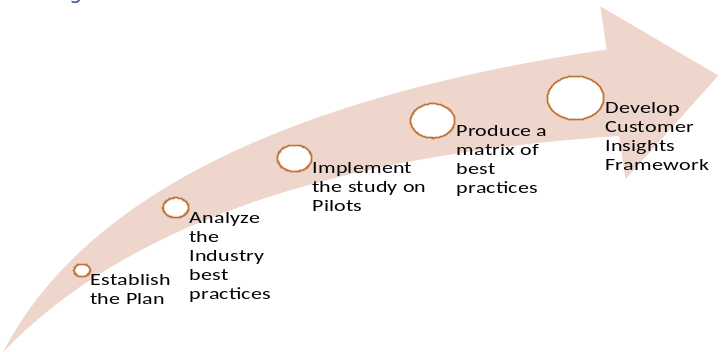
Step 1: Establish the Plan
Establish the plan and requirements around what matters to your firm and understanding the business perspective and baselining the requirements of customer insights. Here we have to identify key parameters to research intelligence on B2B customers. It includes the depth of the research and sources of information.
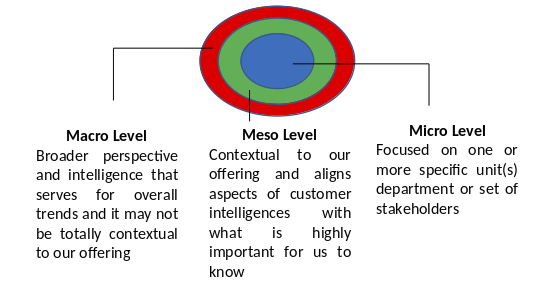
A Medium article by Anne Siig Blond identifies three levels that can help us drill down into the customer information. The research is done on macro, meso, and micro levels.
There are three sources of information that you can use to grab a deeper understanding of the customer. The sources include public, private, and contextual information.
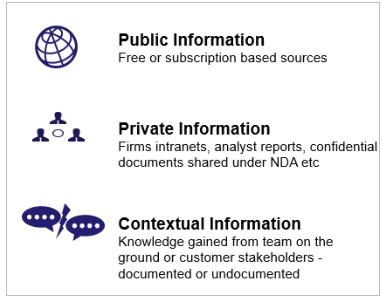
Step 2: Analyzing the Industry Best Practices
Research on industry best practices for relevant sources and identify potential sources for each dimension of customer insights requirements.
Step 3: Implement the Study on Pilots
Baseline the requirements from the key stakeholders and draft a document capturing customer insights for the pilot accounts. The pilot study will help verify the requirements and establish the baseline process.
Step 4: Produce a Matrix of Best Practices
Identify the potential sources captured from the pilot study and Industry practices to derive a matrix of best practices that will lay down the foundation of the final process.
Step 5: Develop Customer Insights Framework
Generate an operating model that can be used to capture customer insights and recommendations for future opportunities.
Examples of Customer Insights Dimensions
The following matrix helps us understand the insights by plotting them with respect to their depth and source of information. Advanced analytics to dig out nuggets of insights and data storytelling to convey them can go a long way in understanding customer priorities from a visual perspective.
For example, technology priorities are an insight that we identified, and it can be researched on a meso level. Here, a large part of the information is captured from private sources, with a little help from public and contextual sources. Pilot studies have identified that one of the richest sources of intelligence is contextual and private, though NDA’s and confidentiality agreements need to be respected.
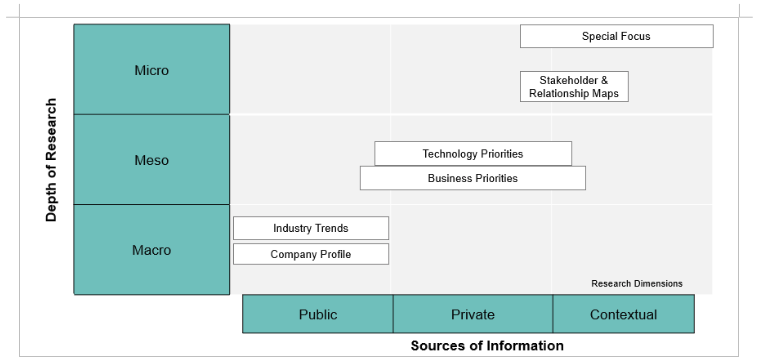
Be a Step Ahead with Right Insights
Generating customer insights is a complex process. If used rightly, insights can help us understand the customer’s business. Therefore, we can prioritize and be one step ahead by providing them the required services.
The model to generate it differs from company to company, depending on its vision and line of work. What might be an insight for you might not be an insight for the other?
There is no single source to capture all the information. Although there are some Account-Based Marketing (ABM) tools available that provide rich information, private and contextual sources play an equally important part. Hence, it is a continuous process that you must carry out to capture the information with the changing dynamics of your customer.
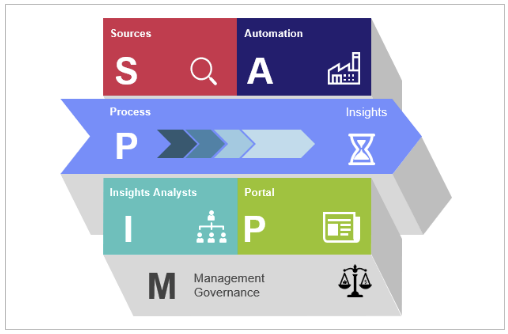
Lastly, while each firm will have its own setup to industrialize the process and imbibe the insights, you can use the operating model framework above as a reference to set up the framework that works for your firm.
Note: This article is researched and written by Gramener’s former Growth Marketing intern Diksha Gadhwal.
Gramener has been helping companies to model customer insights from multiple data sources. You can learn how we build customized NPS Analytics solutions to improve the Net Promoter Score of our clients. We work for many Fortune 500 companies to build custom CX solutions. Team Gramener will help you in defining the CX needs based on your company’s CX maturity and handhold you through the process. For more information, contact Amit Garg at amit.garg@gramener.com.

